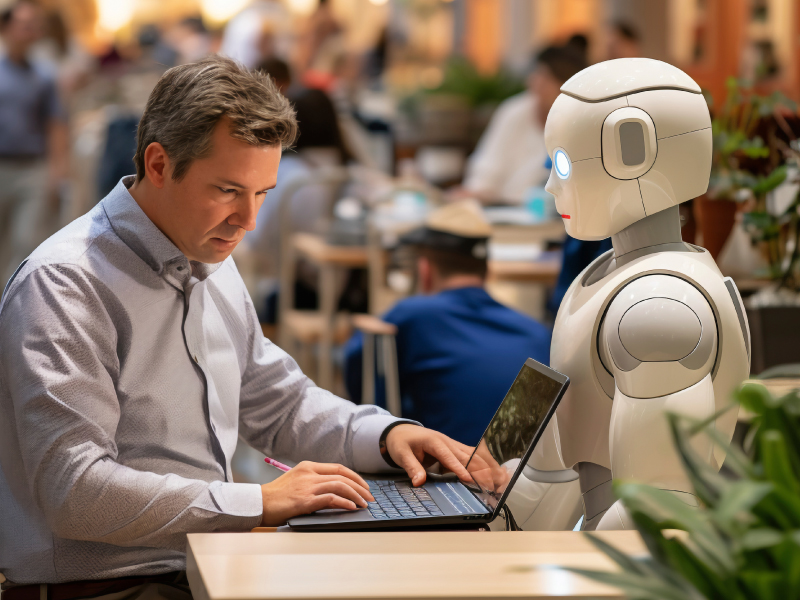The workforce planning (WFM) industry is undergoing a significant transformation as AI-driven digital resources become an integral part of business operations. AI agents are no longer futuristic concepts; they are here (check out CallD.AI) , reshaping the workforce in ways that demand strategic adaptation. From AI-powered real-time analysts to AI interviewers and compliance teams, digital workers are changing the way organisations plan, optimise, and execute workforce strategies.
So, how can workforce planning professionals leverage digital AI resources effectively? And what challenges do they need to navigate?
1. AI in Contact Centres: Agility, Scale, and Speed to Competency
AI agents are transforming customer service operations. Unlike human agents, digital agents can be deployed instantly, scale up or down in real-time to meet demand fluctuations, and provide consistent service 24/7. These capabilities give workforce planning teams unprecedented agility, ensuring organisations can handle peak periods seamlessly. Additionally, while human agents take time to reach full competency, AI agents can be trained and deployed rapidly, significantly reducing ramp-up times.
However, a key challenge lies in balancing digital and human resources. WFM professionals must carefully model AI-human interaction workflows to optimise customer experience and maintain service quality.
2. AI in Real-Time Workforce Optimisation
Real-time workforce analysts play a crucial role in ensuring that contact centres run efficiently and that schedules are kept up-to-date. AI-based real-time tools like #Intradiem can enhance this process by continuously monitoring key workforce metrics, what your staff are doing, and automating scheduling adjustments in real time. This not only improves staff engagement (they don’t get stuck on a call over their lunch break) but also frees human analysts and team leaders to focus on more strategic decision-making.
3. AI in Quality and Compliance: A New Era of Workforce Assurance
AI-driven quality and compliance teams can monitor 100% of interactions, identifying potential compliance risks and quality assurance issues instantly. Unlike traditional sampling-based quality checks, AI ensures comprehensive oversight, enabling faster and more data-driven performance improvements. For team leaders, this means shifting from reactive quality control to proactive management of staff.
4. AI in Recruitment: Do HR Teams Need to Hire Digital Workers?
As AI interviewers and virtual recruiters gain traction, a new question emerges: Should HR teams be involved in the hiring of digital AI agents? Imagine actually interviewing your potential AI Agent about their background, capabilities and knowledge, this is real and here now. If you’d like to see a demo contact us. While traditional hiring processes do not apply to AI workers in the conventional sense, selecting the right AI models, training them on brand-specific data, and continuously optimising their performance is crucial. WFM, Operations and HR leaders must collaborate to ensure AI agents align with business goals and the workforce culture.
5. The Changing Nature of Human Work: Planning for the AI-Human Balance
As AI agents take on high-volume, repetitive tasks, human workers will shift toward more complex, empathetic, and strategic roles. WFM teams must anticipate these changes, redefining job roles, skill requirements, and training strategies. The key is not replacing humans but augmenting them—empowering employees to focus on value-driven work while AI handles efficiency-driven tasks.
6. Ensuring Workforce Harmony: The Human-AI Partnership
For AI resources to be truly effective, they must be deployed in harmony with human workers. This means designing workflows where digital resources complement human skills rather than competing with them. Organisations must foster a culture of collaboration, ensuring employees view digital resources as an enabler rather than a threat. Transparent communication, continuous training, and a clear AI adoption strategy are critical in maintaining a highly engaged workforce.
The Future of Workforce Planning: A Hybrid Model
The rise of AI does not signal the end of human workforce planning—it signals a transformation. The future of workforce management lies in a hybrid model where digital and human resources combine to create highly adaptive, efficient, and scalable workforces.
For workforce planning professionals, the challenge is clear: understanding how to integrate digital resources seamlessly while ensuring the entire workforce remains engaged, empowered, and prepared for the evolving future of work. Those who embrace AI strategically will not only optimise efficiency but also elevate the role of human workers to new heights.
Are you ready to embrace the digital workforce?



